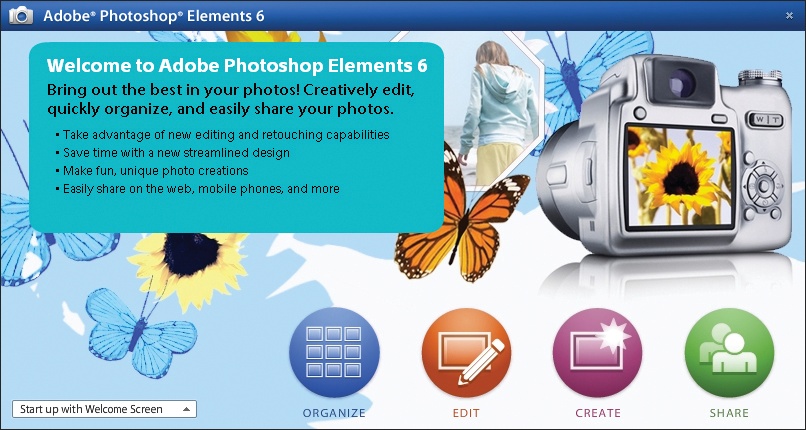Photoshop Elements lets you do practically anything you want to your digital images. You can colorize black-and-white photos, remove demonic red-eye stares, or distort the facial features of people who've been mean to you. The downside is that all those options can make it tough to find your way around Elements, especially when you're new to the program.
This chapter helps get you oriented in Elements. You'll learn about what to expect when you start up the program and how to use Elements to fix your photos with just a couple of keystrokes, as well as how to use the new Guided Edit mode to help you get started editing your photos. Along the way, you'll find out about some of Elements' basic controls and how to get hold of the program's Help files if you need them.
When you launch Elements for the first time, you get a veritable smorgasbord of options, all neatly laid out for you in the Welcome screen (Figure 1-1).
Figure 1-1. The Elements Welcome screen gives you four main activities to choose from. You can't bypass the Welcome screen just by clicking the Close button. When you do, the screen goes away—but so does Elements. Fortunately, you've got options: The box on Organizing Your Photos tells you how to permanently get rid of the Welcome screen.
Interestingly, the Welcome screen isn't actually Elements. It's a launching pad that, depending on the button you click, starts up one of two different programs:
It's quite easy to go back and forth between the Editor and the Organizer—which you might call the two different faces of Elements—and you probably won't do much in one without eventually needing to get into the other. But in some ways, they still function as two separate programs. In any case, the Welcome screen offers you no fewer than four choices for getting into Elements:
Organize takes you to the Organizer, where you can store and sort all your images.
Edit takes you to the Editor, which is the digital darkroom/art studio where you edit your photos and create artwork from scratch.
Create starts you up in the Organizer and gives you a choice of making a Photo Book, Photo Calendar, Photo Collage, Online Gallery, or Slide Show from your photos.
Share also takes you to the Organizer, only this time your options are an Online Gallery, E-Mail Attachments, Photo Mail, Order Prints, and CD/DVD.
If you start in the Organizer, once you've located a photo to edit, you have to wait a few seconds while the Editor loads. And when you have both the Editor and the Organizer running, just quitting the Editor doesn't close the Organizer. You have to close both programs independently. When both programs are running, you can switch back and forth by clicking the button at the upper right of the screen. The button reads "Organizer" when you're in the Editor and "Editor" when you're in the Organizer. You can also just click the Editor or the Organizer icon in the Windows taskbar to switch from one to the other. (The Organizer button just takes a click, but the Editor button includes a pull-down menu where you choose the editing mode you want.)
Adobe has built Elements around the assumption that most people work on their photos in the following way: First, you bring your photos into the Organizer to sort and keep track of them. Then, you open your photos in the Editor to work on them, and save them back to the Organizer when you're finished making changes. You can work differently, of course, like opening photos directly in the Editor and bypassing the Organizer altogether, but you may feel like you're always swimming against the current if you choose a different way of working. The next chapter has a few hints for disabling some Elements features if you really find they're getting in your way.
Get Photoshop Elements 6: The Missing Manual now with the O’Reilly learning platform.
O’Reilly members experience books, live events, courses curated by job role, and more from O’Reilly and nearly 200 top publishers.


